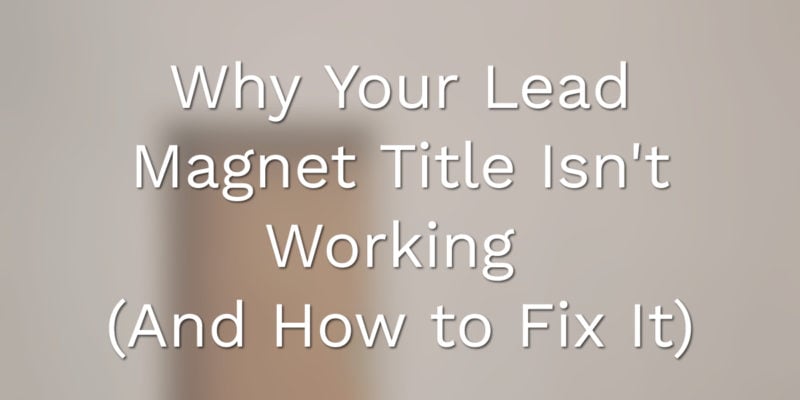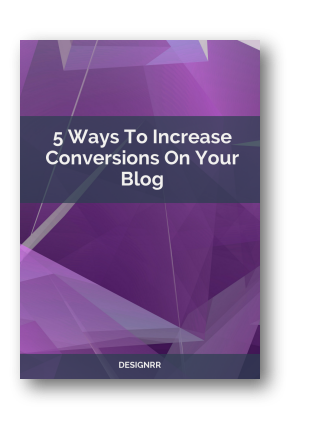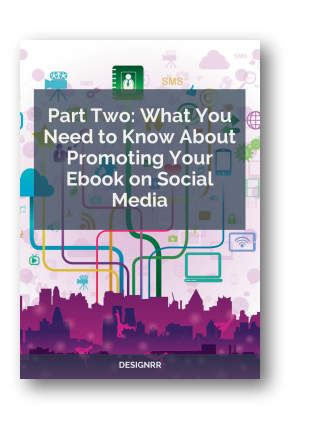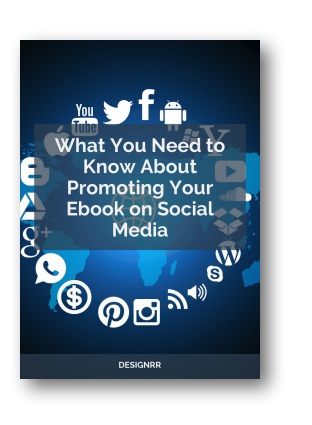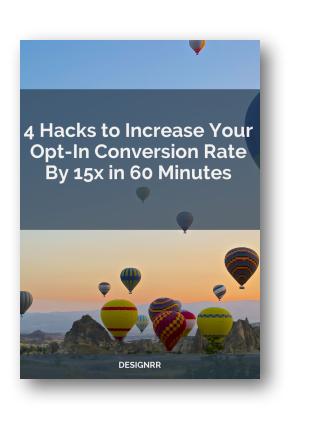You spent weeks creating the perfect lead magnet. A comprehensive guide packed with actionable insights.
You launch it with excitement, but crickets.
Barely anyone downloads it.
Here’s what’s probably happening – your lead magnet could be pure gold, but if your title doesn’t grab attention in those first few seconds, it’s basically invisible.
Think of your title like a storefront window. The products inside might be amazing, but if that window display doesn’t make you stop and look, you just walk right past.
Lead magnet titles bridge the gap between casual visitors and actual subscribers.
I’ve analyzed data from hundreds of successful campaigns and dove deep into what makes people click.
Let me share what actually works in 2025.
What Are Lead Magnet Titles and Why They Matter More Than Ever

A lead magnet title is just the headline that introduces your free offer. Could be an ebook, checklist, webinar, or tool. But it’s way more than just a label – it’s your first and often only shot at communicating value and getting someone to act.
GetResponse conducted research with 790 marketers in 2020 and found something interesting. 47% of marketers said video and text-based lead magnets performed best as their opt-in incentives.
While this data is from 2020, the core principles still hold – format matters, but your title determines if anyone even clicks to see what you’ve got.
Why have titles become so critical in 2025? Information overload. The average person sees thousands of messages daily. Experts call this “decision fatigue.” Your title needs to cut through all that noise instantly.
Think about how your brain works. Daniel Kahneman and Amos Tversky figured out we have two operating systems. System 1 is fast and automatic. System 2 is slow and deliberate. In their research on dual-process theory, they found we spend most of our day in System 1 mode – basically on autopilot when making quick decisions.
This means your title has to pass what I call the “elevator test.” If someone had three seconds in an elevator to understand what you’re offering and why they should care, would your title do the job?
The Psychology Behind High-Converting Lead Magnet Titles

Want to know why certain titles work while others flop? It’s all about understanding the psychological triggers that make people stop scrolling and start clicking.
The Reciprocity Principle in Action
Reciprocity runs deep in human psychology. When you offer something valuable for free, people naturally want to reciprocate. Usually by giving you their email address. But here’s the key part – that perceived value has to be obvious right from your title.
Instead of “Email Marketing Guide,” try “The 3-Email Sequence That Boosted Our Sales 47% (Swipe-Worthy Templates Inside).” See the difference? The second title shows immediate, tangible value with built-in proof.
Instant Gratification in a Fast-Paced World
We live in an era of instant downloads, streaming services, and two-day shipping. People crave immediate rewards. Your title should promise a quick win, not a lengthy commitment.
According to various marketing studies, shorter, more focused content tends to perform better than lengthy resources that require significant time investment. This should directly influence how you position your content in your title.
Authority and Social Proof
People naturally defer to expertise. Including credibility indicators in your titles can seriously boost conversion rates. Here’s how to do it:
- Reference specific numbers – “Used by 10,000+ Marketers”
- Mention credentials – “From a Google Ads Certified Expert”
- Include social proof – “The Strategy 500+ Companies Use”
The Curiosity Gap Principle
Your brain literally fires up just by seeing a question mark. We’re wired to spot questions. Doesn’t matter how busy you are – your brain immediately pays attention when it encounters a question.
Dan Pink proved in “To Sell is Human” that questions outperform statements when it comes to persuading people. Questions create what psychologists call a “curiosity gap” – the space between what people know and what they want to know.
The Data-Driven Breakdown of What Actually Converts
Let’s look at the actual numbers that separate high-performing titles from mediocre ones. This isn’t guesswork – it’s comprehensive industry research.
Short-Form Content Dominates
Here’s a striking trend from recent studies. According to the 2020 GetResponse study, 73% of marketers said they saw the highest conversion rates with short-form video content, like video clips, quick tutorials, or video samples.
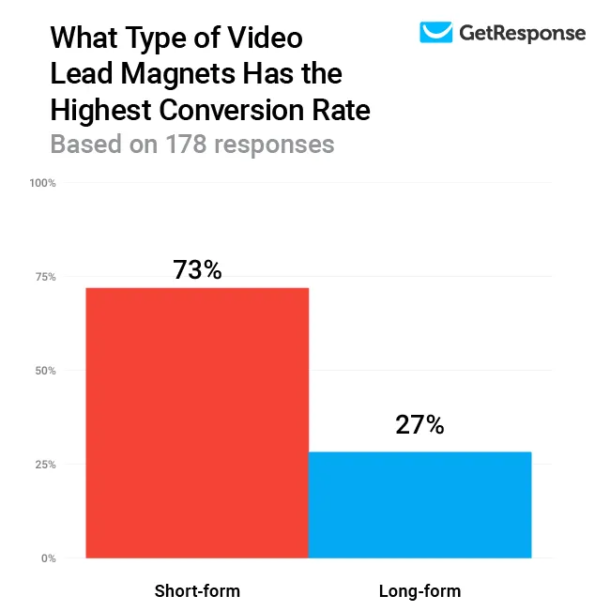
Same pattern with written content. 58.6% of marketers said their short-form written content – like newsletters, checklists, or ebook samples – had the highest conversion rates.
What does this mean for your titles? Promise digestible, actionable content instead of comprehensive tomes. “The 5-Minute SEO Audit” usually beats “The Complete SEO Masterclass.”
Interactive Content Shows Remarkable Performance
Interactive content consistently outperforms passive content in engagement studies. Quizzes, calculators, and assessments are becoming the gold standard for lead generation.
OptinMonster reports that quiz-style lead magnets can boost opt-in rates significantly, with well-designed interactive content seeing strong performance. If you can position your content as interactive or personalized in your title, you’re already ahead of most competitors.
The Power of Numbers in Titles
Numbers are proven attention grabbers, a digit is more space-efficient than a spelt-out number, they promise specific, focused content; they improve the credibility of your lead magnet.
When you use specific numbers in your titles, you trigger what cognitive scientists call the “specificity effect.” Our brains see specific numbers as more credible and trustworthy than vague promises.
Compare these two:
- “Ways to Improve Your Email Marketing”
- “17 Email Subject Lines That Increased Open Rates by 23%”
Which one would you click? The second title uses numbers three ways – quantity (17), outcome (23%), and metric (open rates). This triple-number approach significantly outperforms vague alternatives.
Industry-Specific Performance Data
Different industries see different results with various approaches. According to the 2020 GetResponse study data:
| Industry | Top Performing Format | Key Insight |
| Internet Marketing | Written (27.5%) and Video (26.2%) nearly equal | Both formats work well |
| Ecommerce | Video content dominates | 33.8% prefer video vs 17.6% written |
| Health & Beauty | Strong preference for written content | Significant gap favoring written content |
Source: GetResponse Lead Magnets Study – 2020
This data should inform both your content format and how you position it in your title.
Ten Proven Title Formulas That Generate Results

I’ve analyzed hundreds of successful lead magnets and certain patterns keep showing up. Here are the most effective formulas, backed by psychology and performance data.
Formula 1 – The Specific Benefit Promise
Template: “How to [Achieve Specific Result] in [Timeframe] Without [Common Obstacle]”
Example: “How to Boost Email Open Rates by 40% in 30 Days Without Spending More on Tools”
This works because it hits three psychological triggers – specific outcome, time constraint, and objection handling. It tells prospects exactly what they’ll get and removes common barriers to action.
Formula 2 – The Insider’s Secret
Template: “The [Number] [Industry Secrets/Strategies] That [Desirable Outcome]”
Example: “The 7 Copywriting Secrets That Turned a $50 Ad Into $10,000 in Sales”
This leverages curiosity and our desire for insider knowledge. It suggests you have access to information others don’t, positioning you as an authority.
Formula 3 – The Problem-Solution Bridge
Template: “Why [Common Problem Happens] (And the Simple Fix That [Positive Outcome])”
Example: “Why Your Facebook Ads Aren’t Converting (And the 3-Word Change That Doubled Our Client’s ROI)”
The “reason why” formula works because it suggests that you know why someone experiences a problem and can help them solve it. This is particularly effective because it first validates the reader’s pain point, then promises a specific solution.
Formula 4 – The Toolkit Approach
Template: “The [Adjective] [Tool/Resource] Kit for [Target Audience]”
Example: “The Complete Social Media Template Kit for Busy Entrepreneurs”
Tools and templates consistently perform well because they promise immediate utility. Templates are popular because they save content creators significant time, letting them focus on execution rather than creation.
Formula 5 – The Case Study Format
Template: “How [Company/Person] [Achieved Result] – [Specific Outcome] in [Timeframe]”
Example: “How a Local Bakery Increased Revenue 200% – The Instagram Strategy That Changed Everything”
Case studies work exceptionally well because they provide social proof and real-world validation. They show your strategies work for actual people, not just in theory.
Formula 6 – The Assessment or Quiz Angle
Template: “What’s Your [Assessment Topic]? Take This [Time] Quiz to Find Out”
Example: “What’s Your Marketing Personality? Take This 3-Minute Quiz to Discover Your Ideal Strategy”
Quiz-style lead magnets perform exceptionally well in today’s interactive content landscape. They work because people love learning about themselves and getting personalized insights.
Formula 7 – The Ultimate Resource
Template: “The Ultimate [Resource Type] for [Achieving Goal]”
Example: “The Ultimate Productivity Planner for Overwhelmed Entrepreneurs”
The word “ultimate” communicates authority and completeness. It signals that this resource could be the only one they need on the topic.
Formula 8 – The Time-Bound Challenge
Template: “The [Timeframe] Challenge: [Specific Outcome] in [Time Period]”
Example: “The 7-Day Email Challenge: Double Your Open Rates in One Week”
Time-bound challenges work because they create urgency and promise transformation within a specific timeframe. They also suggest a structured, step-by-step approach that feels manageable.
Formula 9 – The Objection Crusher
Template: “[Desired Outcome] Even If [Common Objection/Limitation]”
Example: “Build a Profitable Blog Even If You Have Zero Writing Experience”
Anticipate a reason a prospect might give for disqualifying themselves and speak to it. Cut ’em off at the pass. This formula directly addresses the most common reasons people don’t take action.
Formula 10 – The Swipe File Approach
Template: “[Number] [Content Type] You Can Copy and Paste for [Outcome]”
Example: “50 Email Subject Lines You Can Copy and Paste for Higher Open Rates”
Swipe files are particularly appealing because they remove the need for creativity or original thinking. They promise ready-made solutions people can use immediately.
Common Title Mistakes That Kill Conversions

Even with good intentions, many marketers sabotage their lead magnets with poor title choices. Let me walk you through the most common mistakes I see and how to fix them.
Mistake 1 – Being Vague or Generic
Problem: Titles like “Marketing Tips” or “Business Guide” tell readers nothing about the specific value they’ll receive.
Solution: Always include specific outcomes or benefits. Instead of “SEO Guide,” use “The 15-Point SEO Checklist That Helped 500+ Websites Rank on Page One.”
Why this matters: Research consistently shows that more specific titles tend to convert better than generic ones. Specificity signals expertise and helps people visualize the exact benefit they’ll receive.
Mistake 2 – Overpromising or Hype Language
Problem: Titles that promise “overnight success” or use excessive superlatives create skepticism and attract the wrong audience.
Solution: Be specific and realistic. “Double Your Email List in 30 Days” is more believable than “Explode Your Email List Overnight!”
The psychology here? People have become incredibly skeptical of hype language. When you overpromise, you trigger what psychologists call “reactance” – people push back against claims that seem too good to be true.
Mistake 3 – Not Using Your Audience’s Language
Problem: Using industry jargon or terms your audience doesn’t use creates disconnect and confusion.
Solution: Research how your audience actually describes their problems. Use their language, not yours. If they say “get more customers,” don’t use “optimize conversion funnels.”
Research insight: According to ConversionXL, customer research should be the foundation of your copywriting. Without it, you won’t be able to create copy that resonates with your target audience at an emotional level.
Mistake 4 – Making It About You, Not Them
Problem: Titles that focus on your expertise or company rather than the reader’s benefits.
Solution: Every title should answer “What’s in it for me?” from the reader’s perspective. Lead with benefits, then support with credibility.
Example of the fix:
- Bad: “John Smith’s Complete Guide to Social Media”
- Good: “The Complete Social Media Guide That Helped 1,000+ Businesses Triple Their Followers”
Mistake 5 – Forgetting Mobile Users
Problem: Long, complex titles that get cut off on mobile devices or are hard to scan quickly.
Solution: According to recent Statista data, mobile devices account for approximately 58% of global web traffic, so test your titles on mobile devices and keep them concise enough to read at a glance.

Find more statistics at Statista
Technical tip: Keep your main benefit within the first 50 characters of your title to prevent mobile truncation.
Mistake 6 – Creating Information Overload
Problem: Trying to include every benefit and feature in your title, which creates cognitive overload.
Solution: Focus on one primary benefit and save secondary benefits for your subtitle or description.
Research shows that complex lead magnets often underperform because they create decision paralysis. The same principle applies to titles – complexity kills conversion.
Mistake 7 – Keyword Stuffing
Problem: When you’re writing about your lead magnet topic, it’s tempting to stuff your title with SEO keywords.
Solution: Focus on one or two main keywords in the title for discoverability, but save additional keywords for your description and landing page copy.
Mistake 8 – Being Too Boring
Headline research shows that boring titles typically lack specificity or clear benefits. A good title is specific and outcomes-focused.
Advanced Lead Magnet Title Enhancement Techniques

Once you understand the basics, these advanced techniques can help you squeeze every ounce of performance from your titles.
The Subtitle Strategy
Here’s how to structure the title-subtitle combination effectively:
Main Title: Grab attention and promise the core benefit
Subtitle: Provide additional context, credibility, or details
Example from Nick Stephenson: “$0 to $1k Per Month: Author Marketing Training” title. But then he also has a “Free Seven Day Course: How to Build Your Author Business to $1k Per Month – And Beyond” subtitle.
The Credibility Hook Technique
The copy hits the reader’s biggest challenge – staying competitive in a noisy sales environment. It leads with a credibility hook (1,400+ sales pros), then delivers concrete reasons to care.
Structure: [Credibility Hook] + [Core Benefit] + [Specific Outcome]
Example: “Used by 1,400+ Sales Pros: The AI Strategy That Boosted Close Rates 34%”
The Framework or System Positioning
Give it a title that shows the freebie is your own framework or system (while being clear on the outcome).
Examples:
- “The Color Palette Promise: How to Choose a Brand Color Palette that Resonates with Your Ideal Clients”
- “Your Forever Colors: The 5-Step System to Choosing Your Brand Color Palette”
This approach works because it suggests proprietary knowledge while maintaining clarity about the outcome.
The Objection Prevention Strategy
Identify exactly whom your lead magnet is for. Why will they object? Overcome the objection in your title.
Common objections and how to address them:
| Objection | Title Solution |
| “I don’t have time” | “The 5-Minute SEO Audit That Reveals Your Biggest Opportunities” |
| “I don’t have money” | “21 Video Marketing Ideas for Zero-Budget Entrepreneurs” |
| “I’m not experienced enough” | “The Complete Beginner’s Guide to Facebook Ads (No Experience Required)” |
| “It won’t work for my industry” | “The Email Sequence That Works for ANY Business (Templates Included)” |
The Problem Agitation Solution Structure
This advanced technique follows a three-part structure within your title:
- Acknowledge the problem: “Why Your Emails Go to Spam”
- Agitate slightly: “The Hidden Mistakes That Kill Deliverability”
- Promise the solution: “And the 7 Fixes That Get You to the Inbox”
Combined example: “Why Your Emails Go to Spam: The Hidden Mistakes That Kill Deliverability (And the 7 Fixes That Get You to the Inbox)”
How to Write Titles for Different Lead Magnet Types

Different types of lead magnets need different title approaches. Here’s how to optimize for each format.
Ebooks and Guides
Focus on comprehensive value and expertise. According to Content Marketing Institute research, comprehensive guides and ebooks consistently rank among the top-performing text-based lead magnets.
Effective approaches:
- “The Complete [Topic] Guide: [Specific Outcome] in [Timeframe]”
- “The Only [Topic] Resource You’ll Ever Need”
- “From Zero to [Desired State]: The [Topic] Roadmap”
Example: “The Complete Email Marketing Guide: From 0 to 10,000 Subscribers in 90 Days”
Got a long form article on your website? Watch this video if you want the most simple and the fastest way to convert your blog into an ebook:
See how easy it is to create lead magnets with Designrr
Sign up for Designrr’s special offer today!
Checklists and Templates
Emphasize immediate utility and time-saving benefits. According to various conversion studies, checklists and cheat sheets significantly outperform generic lead magnets because they provide immediate, actionable value.
Effective approaches:
- “The [Number]-Point [Topic] Checklist [Benefit/Outcome]”
- “The [Topic] Template That [Specific Result]”
- “[Time-Saving] [Topic] Toolkit”
Example: “The 23-Point Website Launch Checklist (Never Miss a Critical Step Again)”
Webinars and Video Content
Highlight the interactive nature and expert access. According to GoToWebinar’s research, webinars remain one of the most effective lead generation formats due to their interactive nature and perceived high value.
Effective approaches:
- “Join Me Live: [Specific Topic] Masterclass for [Target Audience]”
- “Free Training: How to [Achieve Outcome] in [Timeframe]”
- “Behind-the-Scenes: [Case Study/Strategy] That [Result]”
Example: “Join Me Live: The 3-Step System That Doubled My Client’s Revenue (Real Case Study)”
Tools and Calculators
Stress the practical utility and instant results. Interactive tools and calculators perform well because they provide immediate, personalized value to users.
Effective approaches:
- “Free [Tool Type]: Calculate Your [Specific Metric] in Under 5 Minutes”
- “The [Topic] Calculator That Reveals [Insight]”
- “Instant [Analysis/Assessment]: Get Your [Results] Now”
Example: “Free ROI Calculator: See How Much Facebook Ads Should Make You in 60 Seconds”
Quizzes and Assessments
Leverage the high conversion rates of interactive content. Interactive quizzes and assessments perform well because they provide personalized insights and engage users actively rather than passively.
Effective approaches:
- “What’s Your [Topic] Type? [Time] Quiz Reveals All”
- “The [Topic] Assessment That [Reveals/Predicts] [Outcome]”
- “Take This Quiz: Are You Ready for [Next Step]?”
Example: “What’s Your Marketing Personality? This 3-Minute Quiz Reveals Your Perfect Strategy”
Case Studies
Leverage social proof and real-world validation. According to Content Marketing Institute research, B2B marketers find case studies moderately to highly successful as lead magnets because they demonstrate real-world application of strategies.
Effective approaches:
- “How [Company] [Achieved Result]: The [Strategy] Case Study”
- “The [Industry] Success Story: [Specific Outcome] in [Timeframe]”
- “Case Study: [Challenge] to [Success] Using [Method]”
Example: “How a Solo Consultant Hit $100K: The Content Strategy Case Study (With Email Templates)”
Advanced Title Testing and Optimization

Creating great titles requires systematic testing and optimization. Here’s how to approach this scientifically.
What to Test First
According to A/B testing best practices, you should never apply copywriting strategies blindly – always test to see what works best for your specific business and audience.
Priority testing variables:
- Benefit vs. curiosity – “Double Your Email List in 30 Days” vs. “The Email Secret Top Marketers Don’t Want You to Know”
- Specific numbers vs. general promises – “17 Ways to…” vs. “Proven Ways to…”
- Questions vs. statements– “Are You Making These SEO Mistakes?” vs. “The 7 SEO Mistakes Killing Your Rankings”
- Short vs. longer titles – Test 6-8 words against 12-15 words
How to Set Up Valid Tests
Single variable testing: Only test one element at a time for clean data. If you test both the number and the benefit simultaneously, you won’t know which change drove the improvement.
Statistical significance: Run tests until you reach at least 95% confidence. Most A/B testing tools will calculate this automatically.
Audience consistency: Make sure both versions of your test run to similar audience segments at similar times.
Key Metrics to Track
Primary metric: Landing page conversion rates vary widely by industry. While averages differ across studies, focusing on improvement relative to your baseline is more important than hitting specific benchmarks.
Secondary metrics:
- Click-through rate from your promotion channels
- Email engagement rates of new subscribers
- Long-term customer value from each title variant
Google Analytics 4 and specialized attribution tools can help you identify the most effective touchpoints that lead to conversions. Track not just immediate conversions, but which titles produce subscribers who eventually become customers.
Read our article on important metrics to track to see if your lead magnet is working.
The Title-to-Content Alignment Strategy

Your title creates an expectation. If your content doesn’t deliver on that promise, you’ll have high unsubscribe rates and low engagement.
The Promise-Delivery Framework
Step 1: Identify the specific promise in your title
Step 2: Make sure that promise is fulfilled within the first page of your content
Step 3: Exceed the promise with additional, unexpected value
Example:
- Title promise: “The 5-Minute SEO Audit”
- Content delivery: Provide a checklist that genuinely takes 5 minutes to complete
- Exceed expectation: Include bonus tools or templates that make the audit even more valuable
Avoiding the Disappointment Gap
Research consistently shows that your lead magnet needs to strike the right balance between being comprehensive and consumable.
The “disappointment gap” occurs when there’s a disconnect between title promise and content reality. Common gaps include:
- Scope gap: Title promises comprehensive coverage, content is surface-level
- Time gap: Title suggests quick implementation, content requires hours
- Skill gap: Title implies beginner-friendly, content assumes expertise
- Outcome gap: Title promises specific results, content provides only theory
Psychology-Based Title Enhancement
Understanding the deeper psychological principles behind title effectiveness can help you create more compelling headlines.
The Zeigarnik Effect
People remember incomplete or interrupted tasks better than completed ones. You can leverage this by creating titles that suggest an incomplete state that your content will resolve.
Examples:
- “The Missing Piece in Your Content Strategy”
- “What 99% of Marketers Get Wrong About Email”
- “The Facebook Ad Element Everyone Forgets”
Loss Aversion Principle
People are more motivated to avoid losses than to achieve gains. Frame your titles around what people might lose by not taking action.
Examples:
- “The Revenue You’re Losing With Bad Email Subject Lines”
- “Why Your Competitors Are Stealing Your Customers (And How to Stop Them)”
- “The Costly SEO Mistakes That Kill Your Rankings”
Social Proof Integration
Consumer research shows that people trust recommendations from those they know, and landing pages featuring testimonials or social proof typically see improved conversion rates.
Ways to integrate social proof into titles:
- Numbers: “The Strategy 50,000+ Businesses Use”
- Authority: “The Google-Approved SEO Checklist”
- Peer proof: “What Top 1% of Marketers Know About Email”
The Contrast Principle
Create stark contrasts in your titles to make the benefit more compelling.
Template: “[Current Bad State] vs. [Desired Good State]”
Examples:
- “From Crickets to Customers: The Email Sequence That Changed Everything”
- “Stop Begging for Likes: Start Building Real Engagement”
- “Ditch the Guesswork: Get Data-Driven Results”
The key is making the contrast vivid and personally relevant to your audience’s current situation.
Your lead magnet title serves as the gateway to every relationship with every subscriber. In a world where attention spans are shrinking and competition is getting fiercer, your title needs to work harder than ever.
You can have the best content in the world, but if your title doesn’t stop the scroll, no one will discover its value. The formulas, psychology, and strategies in this guide give you everything you need to create titles that convert browsers into subscribers and subscribers into customers.
Start with one formula from this guide and test it against your current approach. The data will tell you everything you need to know about what resonates with your specific audience. Your future subscribers are waiting to find the value you have to offer – make sure your titles give them every reason to take that crucial first step.
Frequently Asked Questions About Lead Magnet Titles
Get answers to the most common questions about creating high-converting lead magnet titles that boost your conversion rates
What makes a lead magnet title effective?
An effective lead magnet title combines specificity, clear benefits, and psychological triggers. It should promise a specific outcome, include numbers when possible, and address your audience’s exact pain points. The title must pass the “elevator test” – someone should understand the value in 3 seconds or less.
How long should my lead magnet title be?
Keep your main benefit within the first 50 characters to prevent mobile truncation, since 58% of web traffic comes from mobile devices. While there’s no strict limit, focus on clarity over length. Test shorter titles (6-8 words) against longer ones (12-15 words) to see what works best for your audience.
Should I use numbers in my lead magnet titles?
Yes, numbers are proven attention grabbers that trigger the “specificity effect” in our brains. Use digits rather than spelled-out numbers, and include specific outcomes when possible. For example, “17 Email Subject Lines That Increased Open Rates by 23%” uses numbers three ways and significantly outperforms vague alternatives.
What’s the biggest mistake people make with lead magnet titles?
Being vague or generic is the biggest mistake. Titles like “Marketing Tips” or “Business Guide” tell readers nothing about the specific value they’ll receive. Always include specific outcomes, benefits, or solutions. Instead of “SEO Guide,” use “The 15-Point SEO Checklist That Helped 500+ Websites Rank on Page One.”
How do I know if my lead magnet title is working?
Track your landing page conversion rates, click-through rates from promotion channels, and email engagement rates of new subscribers. Run A/B tests with at least 95% confidence, testing only one variable at a time. Focus on improvement relative to your baseline rather than hitting specific industry benchmarks.
Should different types of lead magnets have different title approaches?
Absolutely. Ebooks should emphasize comprehensive value, checklists should highlight time-saving benefits, webinars should stress expert access and interaction, tools should promise instant results, and quizzes should leverage personalization. Each format has unique strengths that should be reflected in the title.
How can I use psychology to improve my lead magnet titles?
Leverage the reciprocity principle by showing clear value, create curiosity gaps with questions, use loss aversion by framing what people might lose, include social proof with numbers or authority indicators, and address common objections directly in your title. These psychological triggers tap into how our brains make quick decisions.
What’s the “disappointment gap” and how do I avoid it?
The disappointment gap occurs when there’s a disconnect between your title promise and content reality. Avoid scope gaps (promising comprehensive coverage but delivering surface-level content), time gaps (suggesting quick implementation but requiring hours), and outcome gaps (promising specific results but providing only theory). Always deliver on your title’s promise within the first page.
Can I use the same title formula for all my lead magnets?
While proven formulas provide a good starting point, you should test different approaches for different audiences and content types. What works for B2B might not work for B2C. Start with one formula, test it against your current approach, then gradually experiment with other formulas to find what resonates best with your specific audience.
Should I worry about SEO keywords in my lead magnet titles?
Focus on conversion first, SEO second. Include one or two main keywords naturally in your title for discoverability, but avoid keyword stuffing. Save additional keywords for your description and landing page copy. A title that converts visitors but isn’t perfectly optimized for search will outperform a keyword-stuffed title that doesn’t convert.
